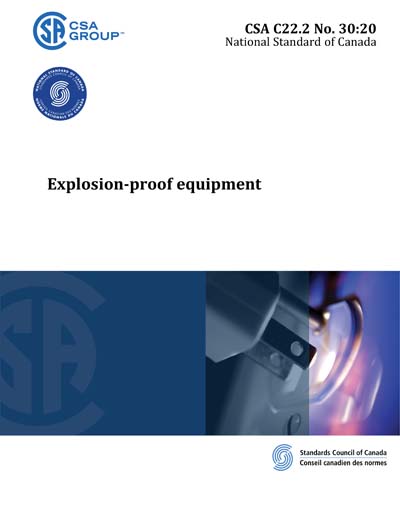Most recent
CSA C22.2 No. 30-2020
Explosion-proof equipment
Preface This is the fourth edition of CSA C22.2 No. 30, Explosion-proof equipment. It supersedes previous editions published in 1986, 1984, and 1970. It is one of a series of Standards issued by CSA Group under Part II of the Canadian Electrical Code. This edition includes requirements for sealing fittings to retain the sealing compound, requirements for the sealing compounds, and requirements for enclosures that involve explosive fluids. For general information on the Standards of the Canadian Electrical Code, Part II, see the Preface of CAN/CSA-C22.2 No. 0, General requirements — Canadian Electrical Code, Part II. This Standard has been developed in compliance with Standards Council of Canada requirements for National Standards of Canada. It has been published as a National Standard of Canada by CSA Group. Scope 1.1 This Standard applies to explosion-proof electrical equipment suitable for use in hazardous locations in accordance with CSA C22.1, Canadian Electrical Code, Part I and the requirements of CSA M421. It applies to explosion-proof enclosures, parts of enclosures and other related equipment constructed of metallic and non-metallic materials. 1.2 Other Standards for hazardous location equipment covering specific types of equipment take precedence over this Standard. 1.3 The standard atmospheric conditions (relating to the explosion characteristics of the atmosphere) under which it may be assumed that equipment can be operated are a) temperature –50 °C to +60 °C; b) pressure 80 kPa to 110 kPa; and c) air with normal oxygen content, typically 21% by volume. Note: Although the standard atmospheric conditions above give a temperature range for the atmosphere of –50 °C to +60 °C, the normal ambient temperature range for the equipment is –50 °C to +40 °C, unless otherwise specified and marked. 1.4 In this Standard, "shall" is used to express a requirement, i.e., a provision that the user is obliged to satisfy in order to comply with the standard; "should" is used to express a recommendation or that which is advised but not required; and "may" is used to express an option or that which is permissible within the limits of the Standard. Notes accompanying clauses do not include requirements or alternative requirements; the purpose of a note accompanying a clause is to separate from the text explanatory or informative material. Notes to tables and figures are considered part of the table or figure and may be written as requirements. Annexes are designated normative (mandatory) or informative (non-mandatory) to define their application.
CSA America, Inc. [csa]

